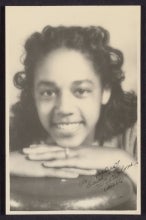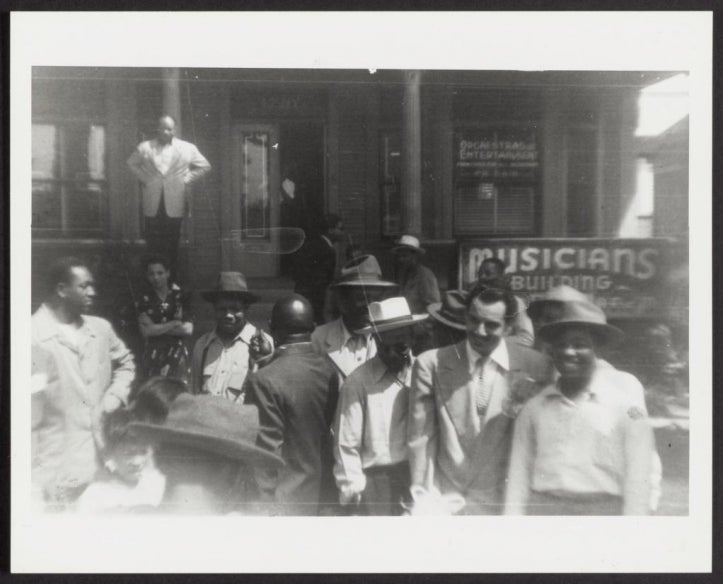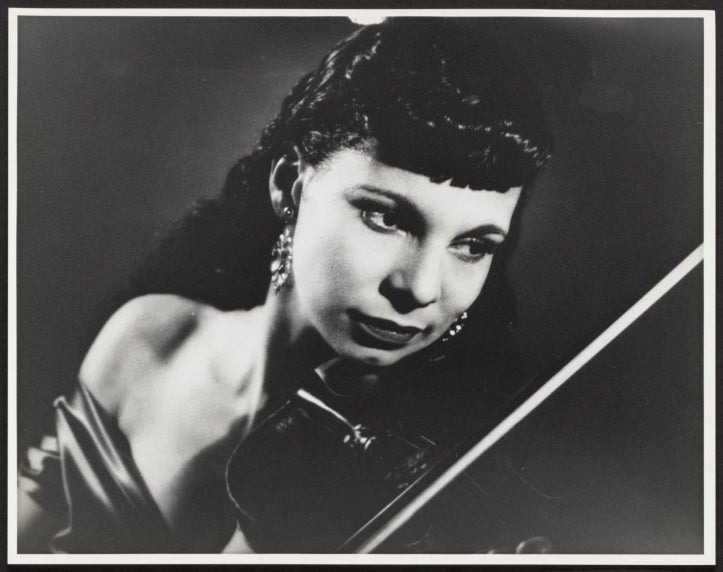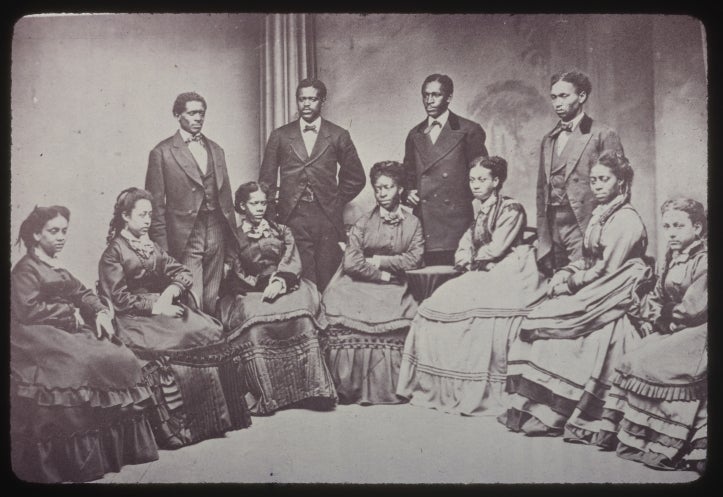Bette Cox Still Images Now Available Online On California Revealed

Bette Yarbrough Cox (1921-2017) was a music educator in Los Angeles for more than 30 years, the founder of the BEEM (Black Experience as Expressed through Music) Foundation for the Advancement of Music, a Commissioner of Cultural Affairs for the City of Los Angeles, and a longtime friend of former Mayor Tom Bradley.
As she recalled to the Los Angeles Times in 1995, the school district first accepted the teaching of Black history in the late 1960s, a seismic shift from her UCLA undergraduate days in 1938. To enhance her classroom curriculum, Cox looked for books about the Black history of music in Southern California. Her search through the usual channels – library shelves, newspaper clippings, etc. – came up mostly empty. Cox decided to do something about this lacuna and spent the next 20 years unearthing the untold history behind the music of Black Los Angeles. She ultimately published her research in the book Central Avenue--Its Rise and Fall, 1890-c. 1955: Including the Musical Renaissance of Black Los Angeles.
As Professor Emerita Jacqueline Cogdell Djedje says of the collection: "Given the fact that African-American musical scholarship has focused primarily on the South, Midwest, and Northeast, the Bette Cox collection is important because it fills a much-needed void. The interviews she conducted with major figures in Los Angeles were used for her book, Central Avenue: Its Rise and Fall (1890-c.1955): Including the Musical Renaissance of Black Los Angeles (1996). Thus, not only was Bette Cox a pioneer in documenting the music of Black Los Angeles, she may have been the first music researcher to bring attention to the importance of the Central Avenue community as a setting for Black musical creativity. Instead of focusing on one genre such as jazz or gospel, her materials cover the entire spectrum of the Black experience in Los Angeles. They provide insights about Los Angeles musical artists representing classical music, religious music, jazz, and more. Since more research is needed on African American regional studies, especially California contributors to the history and development of Black musical traditions, the Cox collection is a major contribution to musical scholarship generally."
The Ethnomusicology Archive holds the Bette Cox collection and is thrilled to announce that the still images relating to African American music and culture in Los Angeles are now available online on the Ethnomusicology Archive channel on California Revealed. California Revealed is a California State Library initiative to help California’s libraries, archives, and cultural heritage groups to describe, digitize, preserve, and provide online access to archival materials that tell the stories of the many diverse communities in the Golden State.
I thought that I would share some of the images now online. You can also view the over 2200 available Bette Cox images online on California Revealed.

Bette Cox with Rosa Parks, c. 1960s. Rosa Parks (1913 - 2005) was an American civil rights activist whose refusal to relinquish her seat on a public bus precipitated the 1955–1956 Montgomery bus boycott in Alabama, which became the spark that ignited the Civil Rights Movement in the United States.

"Colored" Musicians' Union 767 Building at 1710 S. Central Avenue in Los Angeles, California. The building was the home base of the all-Black Local 767 musicians' union in Los Angeles, California. The union's merger with the all-White Local 47 in the 1950s set the precedent for desegregation within the entire musicians’ union of the United States and Canada. This image appears on page 124 of Central Avenue: Its Rise and Fall:1890-c. 1955 by Bette Yarbrough Cox.

Buddy Collette with Groucho Marx in Los Angeles, California, c. 1950. Collette was a jazz flutist, saxophonist, studio musician, educator, composer, and a Los Angeles native, who made an undeniable mark on the city. Collette started his first band at age 12. In 1949, he became the first Black musician to perform on television on You Bet Your Life, hosted by Groucho Marx. In the 1950s, he worked as a studio musician with Frank Sinatra, Ella Fitzgerald, Duke Ellington, Count Basie, Nat King Cole, and Nelson Riddle. In 1955 he was a founding member of the Chico Hamilton Quintet, playing chamber jazz flute with guitarist Jim Hall, cellist Fred Katz, and bassist Carson Smith. He also taught, and his students included Charles Mingus, James Newton, Eric Dolphy, Charles Lloyd, and Frank Morgan. He also helped merge Local 767, the all-Black musicians' union with Local 47, the all-White musicians' union in Los Angeles. He was a faculty member of California State University, Pomona, CSULA, CSULB, California State University Dominguez Hills, and Loyola Marymount University. He was designated a Los Angeles Living Cultural Treasure by the city of Los Angeles and co-founded the JazzAmerica program, a non-profit organization that aims at bringing jazz into classrooms in middle school and high schools in the greater Los Angeles area tuition-free. This image appears on page 296 of Central Avenue: Its Rise and Fall: 1890-c. 1955 by Bette Yarbrough Cox.

Clora Bryant, c. 1950s. Clora Bryant was an American jazz trumpeter. Bryant was the only female trumpeter to perform with Dizzy Gillespie and Charlie Parker and was a member of the all-female jazz bands, International Sweethearts of Rhythm and the Queens of Swing, who were the first women's jazz group to appear on television (as the Hollywood Sepia Tones). She attended UCLA in 1945 and heard bebop for the first time on Central Avenue. She worked in Los Angeles as a trumpeter for Josephine Baker and Billie Holiday. This image appears on page 76 of Central Avenue: Its Rise and Fall: 1890-c. 1955 by Bette Yarbrough Cox.

Ginger Smock, c. 1950s. Violinist Ginger Smock was a critical figure in the development of the Los Angeles jazz scene and a trailblazing leader for female musicians in the male-dominated music industry of the 1940s and 1950s. Her work helped to pave the way for future jazz violinists like India Cooke and Regina Carter.

Josephine Baker. American-born French entertainer, French Resistance agent, and civil rights activist Josephine Baker's career was centered primarily in Europe, mostly in her adopted home of France. She was the first Black woman to star in a major motion picture, the 1927 silent film Siren of the Tropics, directed by Mario Nalpas and Henri Etievant. During her early career Baker was renowned as a dancer and was among the most celebrated performers to headline the revues of the Folies Bergere in Paris. Her performance in the revue Un Vent de Folie in 1927 caused a sensation in Paris. Her costume, consisting of only a short skirt of artificial bananas and a beaded necklace, became an iconic image and a symbol of the Jazz Age in the 1920s.

Lillian Evanti (1890-1967). Evanti became the first African American to sing in a professional European opera company in 1925. The Howard University graduate was also a composer, lyricist, teacher, art collector, activist, lecturer, soror (Zeta Phi Beta), and goodwill ambassador for the U.S. Department of State. She helped to found the National Negro Opera Company (NNCO), starring as Violetta in its production of Verdi's La Traviata. Her tireless advocacy for a national performing arts center, including testifying to a Congressional committee in 1935, contributed to approval for what became the Kennedy Center. Active in her local community, which included the fabled U Street, or Black Broadway, Evanti also performed in Europe, Latin America, and South America. She promoted peace through music through compositions such as Himno Pan-Americano, a bilingual anthem dedicated to the Pan-American Union (now Organization for American States); A Salute to Ghana, commissioned by the Voice of America to honor the newly independent nation in 1957; and United Nations.

The Original Fisk Jubilee Singers, c. 1871. Fisk University opened in Nashville in 1866 as the first American university to offer a liberal arts education to “young men and women irrespective of color.” Five years later the school was in dire financial straits. George L. White, Fisk treasurer and music professor then, created a nine-member choral ensemble of students and took it on tour to earn money for the University. The group left campus on October 6, 1871. Jubilee Day is celebrated annually on October 6 to commemorate this historic day. The first concerts were in small towns. Surprise, curiosity, and some hostilities were the early audience response to these young black singers who did not perform in the traditional “minstrel fashion.” One early concert in Cincinnati brought in $50, which was promptly donated to victims of the notorious 1871 fire in Chicago. When they reached Columbus, the next city on tour, the students were physically and emotionally drained. Mr. White, in a gesture of hope and encouragement, named them “The Jubilee Singers,” a Biblical reference to the year of Jubilee in the Book of Leviticus, Chapter 25. Continued perseverance and beautiful voices began to change attitudes among the predominantly white audiences. Eventually skepticism was replaced by standing ovations and critical praise in reviews. Gradually they earned enough money to cover expenses and send back to Fisk. In 1872 they sang at the World Peace Festival in Boston and at the end of the year President Ulysses S. Grant invited them to perform at the White House. In 1873 the group grew to eleven members and toured Europe for the first time. Funds raised that year were used to construct the school’s first permanent building, Jubilee Hall.





